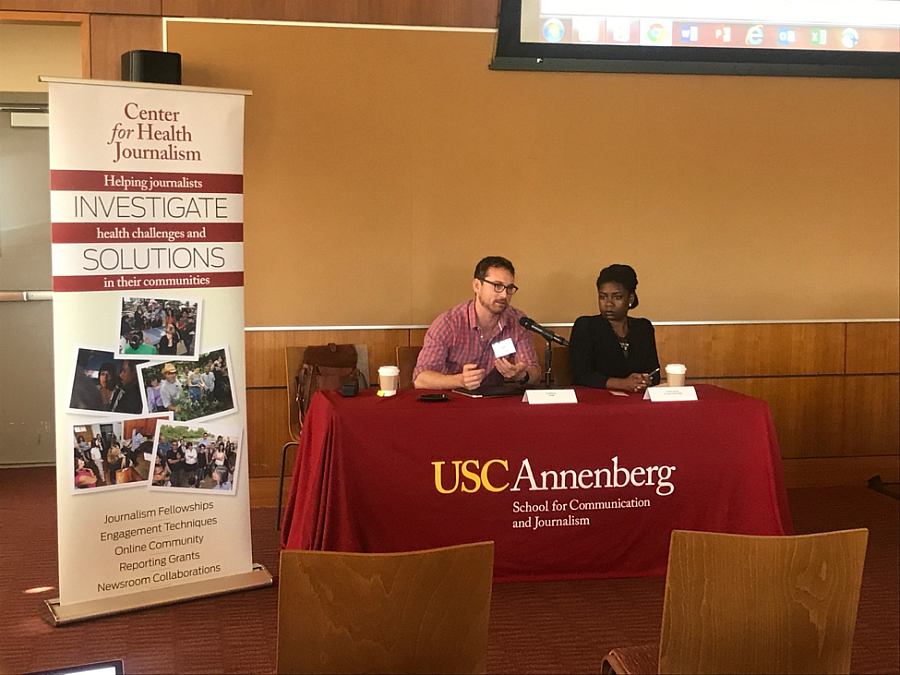How do you gain access and give respect when reporting on communities in crisis? Two reporters share insights

During her stint as a public safety and city hall beat reporter for the Tampa Bay Times, Kameel Stanley spotted a scoop no one else had noticed. Tampa police were issuing a disproportionate number of traffic violations to black bicyclists.
Her reporting on the issue sparked a Department of Justice investigation that found that while black people constituted about a quarter of the city’s population, they accounted for 70 percent of bike stops.
Speaking recently to a group of fellow journalists at the 2017 National Fellowship, Stanley described the initial disbelief she experienced from her editor when she first pitched the story. He found it hard to believe that this kind of discrimination could be happening on such a large scale, without any public outcry. “Your expectation that someone in this situation should be reacting in a certain way, is a problem,” Stanley said. “In journalism, we have these markers we set for things. But this was a story that was happening in broad daylight, and no one was going to city hall to protest.”
As a black person living in the city, Stanley understood the reasons why members of her community would be reluctant to report instances of discrimination from the police to city officials. She also understood why the community would expect little intervention even if they did speak up.
“When we’re talking about going into communities in crisis, communities of color, underserved communities, first of all these are not stories that are new, these are not stories that we don’t already know,” said Stanley. “But I think they come down to an essential question: who do you believe, and why?”
For Edward Williams, whose project for the 2016 National Fellowship highlighted the opioid epidemic through the lens of high school students in one hard-hit county in northern New Mexico, the need to include community voices throughout the reporting process became clear early on.
“We saw a lot of enthusiasm from the expert community, who had become the de facto voice of the opioid crisis, but we got a very different response from the actual people in the midst of the heroin epidemic,” Williams told fellow journalists. “People would roll their eyes at me. It was kind of an exasperation at past coverage mixed with a real desire to tell the story.”
Williams described previous coverage of the epidemic as a form of “addiction porn” that was heavy on statistics and quotes from experts, but light on insight from the people actually affected by the crisis. The reporters most community members in the predominantly Latino county had encountered were largely, like Williams, white. As Williams and his team began talking to local youth, and asking them what they thought needed to be done, and how their story should be told, a common sentiment emerged: The constant barrage of negative press about their community made these kids feel unjustly judged and looked down upon.
“Internalizing a negative discourse about yourself is a real marker to have people fall into addiction,” Williams said. “Journalists are playing a major role in the likelihood of kids falling into this pattern.” With help from a community engagement grant through his fellowship, Williams decided to have the students use their own voices to discuss the problems in their community. Between five features in his series, “Enduring Addiction," Williams worked with a core group of students who served as liaisons between their student body and the school board, discussing what problems they had identified, and what could be done to fix these issues.
“As journalists, we’re not just neutral observers,” said Williams. “You’re a catalyst, and your reporting is either going to help or hurt a community. So, if you’re really not listening to the community, especially a community like this, there’s a good chance that your news coverage can be part of the problem, and not the solution.”
During a discussion session that followed, fellows shared their own experiences with reporting on diverse communities, and the work that must be done behind the scenes to ensure an accurate and honest portrayal. Cristina Londoño shared her experience reporting for Spanish media: “One of the biggest challenges we face is the fact that we are not the same. When you’re walking into each community, you’re walking into different cross sections of the people you’re covering the news for, so you have to come in a humble way, with the position that you’re there to understand the story they’re going to tell through you.”
Reflecting on the initial pushback she received when pursuing the Tampa Bay discrimination story, Stanley said, “I think it just came down to a problem we have in most newsrooms — that there are not a lot of people of color. The people who did the bike story are all people of color. And so, I’m not saying that only people of color can do these stories, but I do wonder what would have happened if two to three white reporters had gotten pushback from their editor and couldn’t vouch for the people within the story. But we will continue having fundamental problems in our newsrooms if they remain mostly white, and mostly male.”
**

